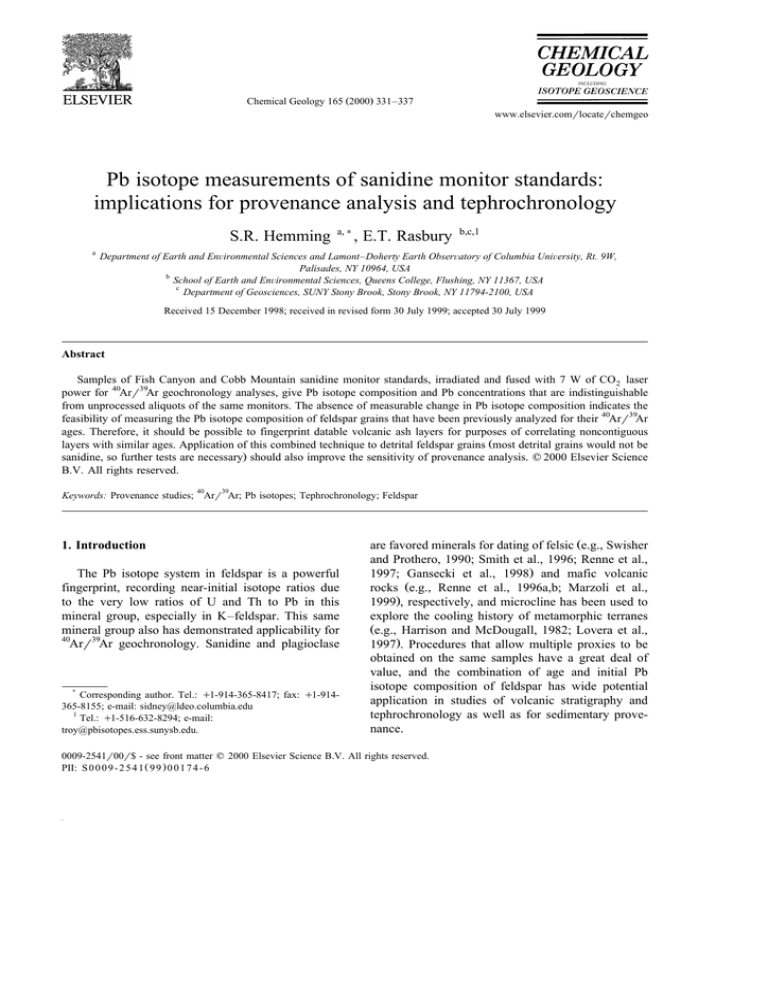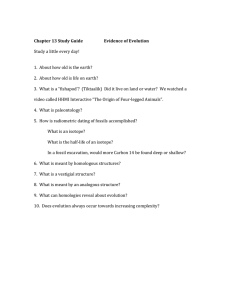
Chemical Geology 165 Ž2000. 331–337
www.elsevier.comrlocaterchemgeo
Pb isotope measurements of sanidine monitor standards:
implications for provenance analysis and tephrochronology
S.R. Hemming
a
a,)
, E.T. Rasbury
b,c,1
Department of Earth and EnÕironmental Sciences and Lamont–Doherty Earth ObserÕatory of Columbia UniÕersity, Rt. 9W,
Palisades, NY 10964, USA
b
School of Earth and EnÕironmental Sciences, Queens College, Flushing, NY 11367, USA
c
Department of Geosciences, SUNY Stony Brook, Stony Brook, NY 11794-2100, USA
Received 15 December 1998; received in revised form 30 July 1999; accepted 30 July 1999
Abstract
Samples of Fish Canyon and Cobb Mountain sanidine monitor standards, irradiated and fused with 7 W of CO 2 laser
power for 40Arr39Ar geochronology analyses, give Pb isotope composition and Pb concentrations that are indistinguishable
from unprocessed aliquots of the same monitors. The absence of measurable change in Pb isotope composition indicates the
feasibility of measuring the Pb isotope composition of feldspar grains that have been previously analyzed for their 40Arr39Ar
ages. Therefore, it should be possible to fingerprint datable volcanic ash layers for purposes of correlating noncontiguous
layers with similar ages. Application of this combined technique to detrital feldspar grains Žmost detrital grains would not be
sanidine, so further tests are necessary. should also improve the sensitivity of provenance analysis. q 2000 Elsevier Science
B.V. All rights reserved.
Keywords: Provenance studies; 40Arr39Ar; Pb isotopes; Tephrochronology; Feldspar
1. Introduction
The Pb isotope system in feldspar is a powerful
fingerprint, recording near-initial isotope ratios due
to the very low ratios of U and Th to Pb in this
mineral group, especially in K–feldspar. This same
mineral group also has demonstrated applicability for
40
Arr39Ar geochronology. Sanidine and plagioclase
)
Corresponding author. Tel.: q1-914-365-8417; fax: q1-914365-8155; e-mail: sidney@ldeo.columbia.edu
1
Tel.: q1-516-632-8294; e-mail:
troy@pbisotopes.ess.sunysb.edu.
are favored minerals for dating of felsic Že.g., Swisher
and Prothero, 1990; Smith et al., 1996; Renne et al.,
1997; Gansecki et al., 1998. and mafic volcanic
rocks Že.g., Renne et al., 1996a,b; Marzoli et al.,
1999., respectively, and microcline has been used to
explore the cooling history of metamorphic terranes
Že.g., Harrison and McDougall, 1982; Lovera et al.,
1997.. Procedures that allow multiple proxies to be
obtained on the same samples have a great deal of
value, and the combination of age and initial Pb
isotope composition of feldspar has wide potential
application in studies of volcanic stratigraphy and
tephrochronology as well as for sedimentary provenance.
0009-2541r00r$ - see front matter q 2000 Elsevier Science B.V. All rights reserved.
PII: S 0 0 0 9 - 2 5 4 1 Ž 9 9 . 0 0 1 7 4 - 6
332
S.R. Hemming, E.T. Rasburyr Chemical Geology 165 (2000) 331–337
The Pb isotope system in detrital feldspar is a
sensitive provenance tool ŽPatterson and Tatsumoto,
1964; McLennan et al., 1993; McDaniel et al., 1994;
Gwiazda et al., 1996a,b; Hemming et al., 1996,
1998., and in many cases, it is possible to analyze
individual sand grains. The value of analyzing individual grains is clear in provenance studies where it
cannot be assumed that any two grains came from
the same source terrane. Despite relatively high con-
centration of Pb in K–feldspar, on average around
50 ppm ŽPatterson and Tatsumoto, 1964., it is not
possible to routinely obtain high quality Pb isotope
measurements on grains between 150 and 250 mm,
although feldspar in this size range is very common
in sandy deposits. In studies of sediment provenance,
the 40Arr39Ar age of a feldspar sample may also
provide important constraints on sources ŽCopeland
and Harrison, 1990, Harrison et al., 1993; D.K Mc-
Fig. 1. 40Arr39Ar ages of detrital hornblende and feldspar grains from core EW9303-GGC31 Ž57.578N, 46.358W, 1796 m.. The numbers
below the bars on the x-axis represent the maximum age in that bin Ži.e., 200 is 0–200 Ma.. These grains were transported to this site at the
opening to the Labrador Sea by icebergs. The potential for the 40Arr39Ar system as a provenance tracer in feldspar is apparent from this
comparison, where feldspar data tend to form well-defined abundance peaks, consistent with hornblende ages, but slightly younger as would
be expected from their closure temperatures. The dashed curve is drawn by linking the tops of feldspar bars, and the solid from the
hornblende bars. Interpreted provenance is indicated by labels with dashed arrows pointing to feldspar peaks and solid arrows to hornblende
peaks. There is a general agreement of peak heights for these two minerals, but there appears to be a much larger representation of
approximately Grenvillian ages from the feldspar grains than from the hornblende grains. The inset in the top right corner shows the
distribution of grains less than 1 Ga for the feldspar population Žbin strategy as for the larger graph., indicating indeed most of the grains fit
better in the Grenville category than in the Appalachian category. This spectrum represents analysis of 45 grains of feldspar and 39 grains of
hornblende from two layers Žabout half from each at 80 and 100 cm in this core, approximately 18 and 20 ky, respectively.. The feldspar
grains could be easily divided into five or seven small groups based on age andror isotope composition, and measured for their Pb isotope
compositions. Many of the 45 grains are too small for individual Pb isotope analysis ŽUnpublished data of S. Hemming..
S.R. Hemming, E.T. Rasburyr Chemical Geology 165 (2000) 331–337
Daniel, unpublished data on Amazon fan and delta..
An example of the potential for 40Arr39Ar geochronology of individual feldspar grains is demonstrated
in Fig. 1. It can be seen from Fig. 1 that the
population of feldspar 40Arr39Ar ages is systematically younger than that of the hornblende from the
same sample, consistent with the lower closure temperature of feldspar. Additionally, it can be seen that
the feldspars from these samples cluster into distinct
age populations Žthat could be further divided based
on CarK that falls out of the Ar isotope analysis of
the grains.. In cases where the Pb abundance is not
adequate for analysis of individual grains, such as in
Amazon fan and delta sands, it may be possible to
combine several grains with similar 40Arr39Ar ages
and CarK ratios, and thus to analyze a small population of grains for their average Pb isotope composition.
Provenance of volcanic rocks may also be constrained by the isotope composition of mineral constituents. 40Arr39Ar geochronology of volcanic sanidine is a highly successful and accepted method of
dating ash layers, but limits on attainable precision
leave open the question of correlation in noncontiguous sections. In favorable cases, radiogenic isotope
measurements could be made on the same crystals
that are used to constrain the age, and this additional
information would settle questions of whether samples are coeval.
The value of multiple proxies derived from the
same individual components is clear, but in order to
apply the combination of 40Arr39Ar dating and Pb
isotope composition, it must first be established that
the irradiation and fusion of feldspar for 40Arr39Ar
geochronology does not compromise the Pb isotope
system. This paper is a report of a pilot project
which we undertook to compare the Pb isotope
composition of dated and undated samples of sanidine monitor standards.
2. Samples and analytical methods
Sanidine from the Fish Canyon Tuff has a reported age of approximately 28 Ma ŽCebula et al.,
1986; Renne et al., 1998.. The Cobb Mountain sanidine monitor standard is from the Alder Creek rhyolite and has a reported age of 1.18 Ma ŽTurrin et al.,
333
1994; Renne et al., 1998.. Both are popular monitor
standards for 40Arr39Ar geochronology.
Samples of Fish Canyon and Cobb Mountain
sanidine monitor standards were loaded into spots in
aluminum disks and co-irradiated with unknown
samples for 40Arr39Ar geochronology in the Cd-lined,
in core facility ŽCLICIT. at the Oregon State University reactor. Single-step laser fusion data were collected at Lamont–Doherty Earth Observatory as part
of routine geochronological measurements. Individual grains were fused with 7 W from a CO 2 laser for
approximately 30 s. Irradiated and fused samples of
the monitor standards were analyzed for Pb, and
compared to untreated aliquots of the same standards. The samples have been irradiated for varying
amounts of time, depending on the age range of the
unknowns, and have been fused in either stainless
steel or copper laser disks Žirradiation duration and
nature of fusion vessel are noted in Table 1..
Samples of several grains each, weighing from
0.44 to 3.8 mg ŽTable 1., were analyzed for their Pb
isotope compositions and Pb concentrations. Samples
were cleaned with quartz distilled water in an ultrasonic bath. Following cleaning, samples were dissolved in 15 min using a mixture of 0.9 ml HF and
0.1 ml 8 N HNO 3 in an ultrasonic bath. A 10%
aliquot of each sample was taken and spiked with a
206
Pb-enriched spike for isotope dilution analysis. A
small amount of 6 N HCl was added to isotope
dilution aliquots and they were stewed for about half
an hour on a hot plate at ca. 1508C. Samples were
dried, and then re-dissolved in 0.7 N HBr for Pb
chemistry. Pb was purified on 100 ml columns with
AG1-X8 anion exchange resin. After cleaning with
multiple passes of quartz distilled water and 6 N
HCl, the columns were equilibrated with 0.7 N HBr,
and samples were loaded and then washed with 720
ml of 0.7 N HBr for removing other ions and 1 ml
water to elute the Pb. Procedural blanks are about
100 pg of Pb, and all samples were greater than 6 ng
of Pb. Reported data are not corrected for blank
contribution.
Pb isotope compositions were measured using the
standard silica gel-phosphoric technique, on a single
collector 12 in. radius Nier-type NBS mass spectrometer at Stony Brook. Filament temperatures were
maintained between 12508 and 13508. Samples were
analyzed in two discrete batches at different times,
S.R. Hemming, E.T. Rasburyr Chemical Geology 165 (2000) 331–337
334
Table 1
Pb isotope data from sanidine samplesa
Sample
Irradiation
time Žh.
Fish Canyon
Irradiated and fused
10 grains c
1
5 grainsd
40
2 grainsd
40
5 grainsd
5
5 grainsd
5
Not treated
10 grains c
0
MS rep d
0
10 grains c
0
MS rep d
0
Cobb Mountain (Alder Creek)
Irradiated and fused
3 grains c
1
MS rep d
1
3 grainsd
0.5
3 grainsd
0.5
Not treated
5 grains c
0
5 grains c
0
Composition
of laser disk
Weight
Žmg.
Pb
Žppm.
206
Stainless
Stainless
Stainless
Copper
Copper
1.9
1.3
0.6
0.5
1.0
12
22
11
30
31
18.530
18.537
18.563
18.469
18.460
0.042
0.200
0.150
0.133
0.131
15.625
15.639
15.620
15.608
15.591
0.046
0.204
0.155
0.136
0.140
37.862
37.934
37.885
37.782
37.744
0.051
0.202
0.166
0.138
0.137
Not fused
Not fused
Not fused
Not fused
1.3
1.3
2.1
2.1
Lost e
18.483
18.432
18.461
18.441
0.043
0.047
0.010
0.010
15.617
15.560
15.591
15.570
0.051
0.048
0.016
0.012
37.865
37.659
37.740
37.668
0.066
0.047
0.018
0.013
Stainless
Stainless
Copper
Copper
1.6
1.6
2.6
2.5
46
35
60
19.125
19.124
19.148
19.141
0.023
0.016
0.040
0.060
15.661
15.650
15.658
15.649
0.025
0.018
0.045
0.063
38.899
38.837
38.887
38.855
0.034
0.018
0.045
0.063
Not fused
Not fused
3.6
3.8
48
32
19.141
19.143
0.021
0.031
15.656
15.652
0.031
0.038
38.876
38.847
0.029
0.032
13
204
Pbr
Pb
"%b
207
204
Pbr
Pb
"%b
208
204
Pbr
Pb
"%b
a
Reported data are corrected for mass discrimination based on standard values reported in analytical procedures.
Uncertainties in this table are reported as in-run precision. External precision from standard analyses is reported in the analytical
procedures, and in most cases, is the dominant uncertainty, i.e., the uncertainty is approximately equal to the external reproducibility.
However, for several of the runs from batch 2, the in-run uncertainty is ) 0.1% and the total uncertainty is accordingly larger.
c
Samples from batch 1.
d
Samples from batch 2.
e
Sample partly spilled before spiking.
b
and with different batches of silica gel, the first from
Gerstenberger and Haase Ž1997. and the second
mixed from a separate batch of colloidal silica from
the same source, provided by K. Mezger. Values for
SRM982 in the first batch are 207 Pbr206 Pb s
0.46656 " 0.00020; 208 Pbr 206 Pb s 0.99774 "
0.00078; 206 Pbr204 Pb s 36.651 " 0.036. The reported uncertainties are 2 s external reproducibility,
based on 21 replicates near the time of the feldspar
analyses. The second batch of SRM982 measurements are 207 Pbr 206 Pb s 0.46679 " 0.00024;
208
Pbr206 Pb s 0.99886 " 00058; 206 Pbr204 Pb s
36.694 " 0.024, based on 10 replicates near the time
of the feldspar analyses. Data reported in Table 1 are
corrected for mass fractionation based on the deviation of these values from the U.S. National Bureau
of Standards recommended values of 207 Pbr206 Pb s
0.46707;
36.739.
208
Pbr206 Pb s 1.00016;
206
Pbr204 Pb s
3. Results and discussion
Pb isotope data from Fish Canyon and Cobb
Mountain monitor standards are shown in Table 1
and Fig. 2. The irradiated and fused samples are
compared to the control samples of the same monitor
standards to determine how much Pb might have
been lost during the fusion process and how close
the isotope composition of the irradiated and fused
sample is to that of an unprocessed sample. Although
there is a relatively large variation in the observed
Pb concentrations among the samples, there is no
clear trend toward significantly lower Pb abundance
S.R. Hemming, E.T. Rasburyr Chemical Geology 165 (2000) 331–337
335
processes. The Fish Canyon sanidine samples that
were fused in stainless steel are slightly offset to the
right on the Pb–Pb diagrams, not along mass fractionation trends Žshown as dashed lines through untreated samples., and we think this is likely a small
contamination from the laser dish.
The Pb isotope composition of irradiated and
fused samples remains a robust measure of provenance. The insignificant loss of Pb probably results
from a combination of short heating time and rapid
cooling against the metal sample holder as well as
the tendency for the silicate matrix to retard the
volatilization of Pb. The latter is much like the
approach that is widely used in the analysis of Pb by
thermal ionization mass spectrometry ŽCameron et
al., 1969.. It is recommended that samples be fused
in copper rather than stainless steel as there appears
to be a slight contamination from the stainless steel,
and no detectable difference is found for samples
fused in copper.
3.1. Potential applications to tephrochronology
Fig. 2. Pb isotope data from sanidine monitor standards. ŽA.
Pbr204 Pb vs. 206 Pbr204 Pb. m s8 curve from 4.57 Ga is
shown for reference Ž m is 238 Ur204 Pb.. Scale is similar to the
field that might be shown in petrogenetic studies involving Pb
isotopes, and shows that the isotope compositions are clearly
separable outside of analytical uncertainty Žsmaller than symbols
for 206 Pbr204 Pb.. The dashed line along the lower values of Fish
Canyon sanidine is a mass fractionation trend, and the small dots
along the line are the extremes measured for mass spectrometer
replicates of one sample of untreated Fish Canyon. ŽB. 208 Pbr
204
Pb vs. 206 Pbr204 Pb. m s8, k s 4 curve is shown for reference
Ž k is 232 Thr238 U.. The difference in the 208 Pbr204 Pb between
these samples is also large relative to the analytical uncertainty.
207
in the fused samples relative to untreated samples.
Due to the small sample sizes and aliquoting for the
isotope dilution, there is a large uncertainty in the Pb
concentrations. However, in order to substantially
fractionate the Pb isotope composition of the remaining Pb, there would have to be near-quantitative loss
of Pb from the fusion process, and this is clearly not
the case. Additionally, the small differences in isotope composition between dated and undated samples cannot be related to simple mass fractionation
Within single volcanic centers, there are variations in radiogenic isotope compositions that are
related to the petrogenesis of magmas. In general,
variations between volcanic centers would be greater
than those within a single center, although there are
certainly exceptions to this generalization. The potential of combined Ar and Pb isotope analyses in
tephrochronology takes two complementary forms.
Tephrachronologists do a remarkable job of correlating volcanic units on the basis of elemental Žmostly
major elements. composition of glasses. This technique can be applied to very small and very few
pieces of glass from disseminated volcanics within
sediment. The combined 40Arr39Ar–Pb isotope approach we suggest would not be applicable in this
situation. However, there are situations where discrete ash layers contain abundant sanidine with very
homogeneous age populations, that are excellent candidates for direct dating of the sedimentary record.
An excellent precision on 40Arr39Ar analysis of two
layers, located at similar stratigraphic horizons but in
noncontiguous basins, might give ages that are very
similar, and yet they still might or might not be from
the same volcanic event. We propose that a further
test of whether they are cogenetic is radiogenic
336
S.R. Hemming, E.T. Rasburyr Chemical Geology 165 (2000) 331–337
isotope analyses of the sanidines. This is not to
ignore other means of tracing and correlating volcanic layers, but to add one more constraint to the
problem. Another significant problem in dating volcanic ash layers within sedimentary successions
Žbrought to our attention by Carl Swisher, personal
communication, 1999., is the likelihood of encountering detrital contaminants. One good way to diagnose this problem during 40Arr39Ar dating is examination of the age and CarK of individual grains,
using the measured 37Arr39Ar. An additional test
would be other geochemical measures of the sanidines. For example, grains that are large enough
could be further tested for Pb isotope heterogeneity
after 40Arr39Ar dating of individual grains.
3.2. Potential applications to proÕenance studies
As noted in Section 1, the Pb isotope system is a
powerful provenance tool for detrital feldspars Že.g.,
Gwiazda et al., 1996a,b; Hemming et al., 1996,
1998, Hemming et al., in review., but there are cases
where low concentrations of Pb combined with small
grain size makes it impossible to obtain high quality
Pb isotope data on individual grains Žpersonal communication from D.K. McDaniel 1998.. It appears
that the 40Arr39Ar chronometer can provide good
constraints on feldspar sources as well Že.g., Copeland
and Harrison, 1990, Harrison et al., 1993; D.K McDaniel unpublished data on Amazon fan and delta..
The application of this system provides several potential advantages. One is the rapidity of analysis of
individual grains Žit is possible to measure, on average, about 40 grains in a day. relative to that of Pb
isotopes Žabout 1 day of preparation and 1 day of
mass spectrometry for - 20 grains.. Another is the
potential for grouping individual grains into populations of like age and CarK together for Pb isotope
analyses. Gwiazda et al. Ž1996b. has demonstrated
that composites of 75 to 300 grains of feldspar from
North Atlantic ice-rafted sand can be a valuable
means of determining the average Pb isotope composition, but composites will mostly be mixtures from a
number of different source terranes, except in rare
cases such as some of the anomalous ice-rafted
detritus deposits, known as the Heinrich layers. In
Heinrich layers H1, H2, H4, and H5, the feldspar
grains exhibit a range of isotope compositions that is
fully consistent with derivation from a single source
terrane ŽGwiazda et al., 1996a,b; Hemming et al.,
1998., whereas in Heinrich layers H3 and H6 there is
a greater mixture of sources ŽGwiazda et al., 1996b..
The histogram plots in Fig. 1 show the relative
distribution of detrital feldspar and hornblende
40
Arr39Ar ages from North Atlantic ice-rafted detritus from core EW9303-GGC31 located atop Orphan
Knoll. Based on our earlier work, this will be a good
test case for the comparison between the 40Arr39Ar
and Pb isotope systems because most of these are
grains that are large enough to expect good Pb
isotope data from individual grains. Due to their
being naturally mixed, the test will not be quite as
clear as that presented here for monitor standards
where the ages and Pb isotopes are homogeneous
and the variations might be expected to largely relate
to lab processing. However, it will be possible to
take a second batch, approximately the same size, of
feldspars that have not been dated, and to analyze
them for their individual Pb isotope ratios. That test
is beyond the scope of the current contribution,
which is just to make a reasonable case that the
procedure is viable.
4. Conclusion
The Pb isotope composition and concentration of
Pb in two samples of sanidine were unchanged by
irradiation and fusion necessary for 40Arr39Ar
geochronology. This successful test means that the
way is open to apply combined 40Arr39Ar and Pb
isotope ratios to geological questions such as tracing
volcanic ash layers for tephrachronology or tracing
the sources of sedimentary grains.
Acknowledgements
Hannes Brueckner, Wally Broecker, and Gary
Hemming are thanked for commenting on an earlier
draft of this manuscript, and Mona Becker for reading a recent version. Thanks to Millie Klas-Mendelson for sample preparation for Pb isotope analysis,
and to Gil Hanson for access to mass spectrometer
facilities at Stony Brook, and Mona Becker for help
in the lab. Thanks to the Potsdam group for their
donation of a small aliquot of silica gel used in batch
S.R. Hemming, E.T. Rasburyr Chemical Geology 165 (2000) 331–337
1, and to Klaus Mezger for contributing a batch of
the silica colloid for making a large batch of silica
gel, used in batch 2. Journal reviewers C. Swisher
and G. Odin provided constructive criticism, which
improved the value of the paper. We gratefully
acknowledge the support of NSF OCE96-33554 to
SRH Lamont contribution a5989. [PD]
References
Cameron, A.E., Smith, D.H., Walker, R.L., 1969. Mass spectrometry of nanogram-size samples of lead. Anal. Chem. 41,
525–526.
Cebula, G.T., Kunk, M.J., Mehnert, H.H., Naeser, C.W.,
Obradovich, J.D., Sutter, J.F., 1986. The Fish Canyon Tuff, a
potential standard for the 40Ar– 39Ar and fission track dating
methods. 6th Int. Conf. on Geochronology, Cosmochronology
and Isotope Geology, Cambridge, p. 139.
Copeland, P., Harrison, T.M., 1990. Episodic rapid uplift in the
Himalaya revealed by Ar-40rAr-39 analysis of detrital K–
feldspar and muscovite, Bengal Fan. Geology 18, 354–357.
Gansecki, C.A., Mahood, G.A., McWilliams, M., 1998. New ages
for the climactic eruptions at Yellowstone: single-crystal Ar40rAr-39 dating identifies contamination. Geology 26, 343–
346.
Gerstenberger, H., Haase, G., 1997. A highly effective emitter
substance for mass spectrometric Pb isotope ratio determinations. Chem. Geol. 136, 309–312.
Gwiazda, R.H., Hemming, S.R., Broecker, W.S., 1996a. Tracking
the sources of icebergs with lead isotopes: the provenance of
ice-rafted debris in Heinrich layer 2. Paleoceanography 11,
77–93.
Gwiazda, R.H., Hemming, S.R., Broecker, W.S., 1996b. Provenance of icebergs during Heinrich event 3 and the contrast to
their sources during other Heinrich episodes. Paleoceanography 11, 371–378.
Harrison, T.M., McDougall, I., 1982. The thermal significance of
potassium feldspar K–Ar ages inferred from 40Arr39Ar age
spectrum results. Geochim. Cosmochim. Acta 46, 1811–1820.
Harrison, T.M., Copeland, P., Hall, S.A., Quade, J., Burner, S.,
Ojha, T.P., Kidd, W.S.F., 1993. Isotopic preservation of Himalayan Tibetan uplift, denudation, and climatic histories of 2
molasse deposits. J. Geol. 101, 157–175.
Hemming, S.R., McDaniel, D.K., McLennan, S.M., Hanson, G.N.,
1996. Pb isotope constraints on the provenance and diagenesis
of detrital feldspars from the Sudbury Basin, Canada. Earth
Planet. Sci. Lett. 142, 501–512.
337
Hemming, S.R., Broecker, W.S., Sharp, W.D., Bond, G.C.,
Gwiazda, R.H., McManus, J.F., Klas, M., Hajdas, I., 1998.
Provenance of the Heinrich layers in core V28-82, northeastern Atlantic: 40Ar– 39Ar ages of ice-rafted hornblende, Pb
isotopes in feldspar grains, and Nd–Sr–Pb isotopes in the fine
sediment fraction. Earth Planet. Sci. Lett. 164, 317–333.
Hemming, S.R., Gwiazda, R.H., Andrews, J.T., Broecker, W.S.,
Onstott, T.C., Jennings, A.E. Isotopic constraints on sediment
sources to Baffin Island moraines. Can. J. Earth Sci., in press.
Lovera, O.M., Grove, M., Harrison, T.M., Mahon, K.I., 1997.
Systematic analysis of K–feldspar Ar-40rAr-39 step heating
results: 1. Significance of activation energy determinations.
Geochim. Cosmochim. Acta 61, 3171–3192.
Marzoli, A., Renne, P.R., Piccirillo, E.M. et al., 1999. Extensive
200-million-year-old continental flood basalts of the Central
Atlantic Magmatic Province. Science 284, 616–618.
McDaniel, D.K., Hemming, S.R., McLennan, S.M., Hanson, G.N.,
1994. Petrographic, geochemical, and isotopic constraints on
the provenance of the Early Proterozoic Chelmsford Formation, Sudbury Basin, Ontario. J. Sediment. Res., Sect. A 64,
362–372.
McLennan, S.M., Hemming, S.R., McDaniel, D.K., Hanson, G.N.,
1993. Geochemical approaches to sedimentation, provenance
and tectonics. In: Johnson, M.J., Basu, A. ŽEds.., Processes
Controlling the Composition of Clastic Sediments, Geol. Soc.
Am. Special Paper, 284, pp. 21-40.
Patterson, C., Tatsumoto, M., 1964. The significance of lead
isotopes in detrital feldspar with respect to chemical differentiation within the earth’s mantle. Geochim. Cosmochim. Acta
28, 1–22.
Renne, P.R., Glen, J.M., Milner, S.C., Duncan, A.R., 1996a. Age
of Etendeka flood volcanism and associated intrusions in
southwestern Africa. Geology 24, 659–662.
Renne, P.R., Deckart, K., Ernesto, M., Feraud, G., Piccirillo,
E.M., 1996b. Age of the Ponta Grossa dike swarm ŽBrazil.,
and implications to Parana flood volcanism. Earth Planet. Sci.
Lett. 144, 199–211.
Renne, P.R., Sharp, W.D., Deino, A.L. et al., 1997. Ar-40rAr-39
dating into the historical realm: calibration against Pliny the
Younger. Science 277, 1279–1280.
Renne, P.R., Swisher, C.C., Deino, A.L. et al., 1998. Intercalibration of standards, absolute ages and uncertainties in 40Arr39Ar
dating. Chem. Geol. 145, 117–152.
Swisher, C.C., Prothero, D., 1990. Single crystal Ar-40rAr-39
dating of the Eocene–Oligocene transition in North America.
Science 249, 760–762.
Turrin, B.D., Donnellynolan, J.M., Hearn, B.C., 1994. 40Arr39Ar
ages from the rhyolite of Alder-Creek, California-age of the
Cobb-Mountain normal-polarity subchron revisited. Geology
22, 251–254.







